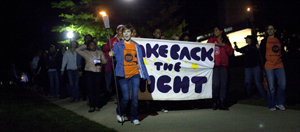By Kathryn Richter/Staff Reporter
Student government plans on moving its meeting places to different residence halls in order to reach students in their own living spaces.
Pemberton Hall will be the first location for the Student Senate’s “Senate on the Road” project on Oct. 12.
Carissa Dauphin, a sophomore communication disorders and sciences major, lives in Pemberton Hall.
“I think it would be beneficial to know what’s going on on-campus,” Dauphin said.
She said she would like to know what the student government is doing and how it is going to affect campus.
Dauphin also said she feels that word of mouth throughout Pemberton will cause more students to attend the meeting.
Marielle Sarkan, a sophomore marketing major, said she felt there may not be too many people attending, since Pemberton is such a small building and most events are heard by word-of-mouth.
Amanda Feder, a junior communication studies major, shares Sarkan’s view on attendance rates.
“I don’t know if it’s going to be a huge number,” Feder said.
Sarkan said there might be a bigger turnout if enough people are curious about student government.
Dauphin said that she would be willing to attend a student senate meeting if it was closer to her.
“If the meeting is in Carman, I can’t guarantee that I would go,” she said, “The closer the meeting, the more willing I would be to show up.”
Sarkan said she felt if the student government continued the “Senate on the Road” program in the future, more people would attend the meeting.
Feder said she was also unaware about the daily activities of the student government, but felt like it would be beneficial for students to attend so they could get a sense of what is going on.
Mary Lane, the student vice president of business affairs and a junior elementary education major said “Student on the Road” might make student government more accessible to students.
“Hopefully it will get more people to understand their welcome to the meetings,” Lane said.
Lane also said she felt it would be beneficial for students to attend the meeting, so more students would become aware of what the student government does.
Feder said she also felt some students would be more willing to attend the meeting since it is closer to them.
Alex Boyd, a junior political science major and a student senate member, said the “Student on the Road” meeting is a good way to increase student turnout and get more feedback from students.
Kathryn Richter can be reached at 581-7942 or kjrichter@eiu.edu


